|
Memorials, Monuments and Plaques.
Memorials,
Monuments and Plaques bearing the Combined Operations Insignia or having a
strong association with Combined Operations.
Please E-mail
your nominations
providing brief details. Scroll down or click on the
links below.
England
Scotland
France
Netherlands
Rest of the World
ENGLAND
  Subject. Combined Operations Command Memorial. Subject. Combined Operations Command Memorial.
Location.
National Memorial
Arboretum, Alrewas, Staffordshire, England.
Other Information.
On Thursday, July 4th, 2013,
in the presence of Her Majesty's Lord Lieutenant of Staffordshire , Mr
Ian Dudson CBE and 200 guests, the
Combined Operations Command Memorial was unveiled
by General Sir Richard Barrons KCB CBE ADC Gen, Commander of the
Joint Forces Command. 25 WW2 Veterans also attended.
  Subject. RN Commandos. No.3 R.N. Commandos were billeted in the town of Hythe prior to
embarkation for Normandy from Hythe Pier. Subject. RN Commandos. No.3 R.N. Commandos were billeted in the town of Hythe prior to
embarkation for Normandy from Hythe Pier.
Location. The Memorial Stone is situated in
a small park close to Hythe Pier.
Other Information. The stone was erected
by the town's folk to commemorate the event.
  Subject. Naval
Commandos. British and allied naval commando units sailed from the Hamble River
on the night of 5th June, 1944, for the D-Day landings on the Normandy
Beaches. Subject. Naval
Commandos. British and allied naval commando units sailed from the Hamble River
on the night of 5th June, 1944, for the D-Day landings on the Normandy
Beaches.
Location. Memorial to the D-Day Landings, Warsash Pier,
Warsash, Hampshire.
Other Information. This memorial was unveiled by
Countess Mountbatten, 5th June, 1984, during the 40th Anniversary
Commemoration.
  Subject.
Mulberry Harbours. Subject.
Mulberry Harbours.
Location. Conwy, North Wales. Follow signs for the marina. The plaque
is situated in the council car park next to Conwy Marina.
Other Information.
Read the full story
about the design, testing, development and manufacture of the
Mulberry Harbours and of the key
role of a local boy cum civil engineer
 Subject.
Operation
Tiger. The disastrous USA amphibious landing training
exercise in Lyme Bay involving the loss of 749 men. Subject.
Operation
Tiger. The disastrous USA amphibious landing training
exercise in Lyme Bay involving the loss of 749 men.
Location. Slapton Sands on
the A 379 about 10 miles south of Brixham.
Other Information. See
Operation Tiger on this website.
  Subject.
Officers and men of 46 Royal Marine Commando, whose HQ was
in the Upper Chine School prior to the Normandy landings. Subject.
Officers and men of 46 Royal Marine Commando, whose HQ was
in the Upper Chine School prior to the Normandy landings.
Location.
Shanklin on the Isle of
Wight just through the old Village.
Other Information.
The building was
used throughout the war and at one stage was the HQ of No.2 Commando...
it
was
demolished in 2002. Also in Shanklin Chine, there is a cafe with lots of
photographs of the commandos training in the area. It is well worth a
look. See also bottom of
PLUTO page.
  Subject. Royal Canadian Army Service Corps. Subject. Royal Canadian Army Service Corps.
Location.
The New Forest close by the town of Southsea.
Other
Information. The site was occupied by the Corp prior to the D-Day landings.
  Subject.
Royal Navy Servicemen (Walcheren). Subject.
Royal Navy Servicemen (Walcheren).
Location. St Michael's Church,
Blandford Road, Hamworthy, near Poole.
Other Information. As a Petty
Officer on LCH 269 (Commander Sellar's ship) for the
Walcheren Operation, Basil Woolf recalls, that on return to Poole the
ship's company decided to make a collection for a temporary Lych gate in a
church. Years later, more money was obtained and a permanent Lych gate was
installed on 5 July, 1952. It was unveiled by the Bishop of Salisbury.
Attending, among survivors, were Admiral of the Fleet, Sir Phillip Vian,
Commander Sellar and a representative of the Dutch Embassy.
 Subject.
LST & Landing Craft Association memorial. Subject.
LST & Landing Craft Association memorial.
Location.
The National
Memorial Arboretum in Staffordshire.
Other Information.
SCOTLAND
 Subject. Commando
Memorial. Subject. Commando
Memorial.
Location. Spean Bridge, about 10 miles
NE of Fort William on the A82 to Inverness.
Other Information. Commandos of many nationalities
did much of their training in the surrounding hills and at nearby Achnacarry.
The monument was unveiled by Queen Elizabeth the Queen Mother in 1953.
 Subject. HMS Quebec, a
Royal Navy base, part of the No 1 Combined Training Centre. Subject. HMS Quebec, a
Royal Navy base, part of the No 1 Combined Training Centre.
Location. A few miles
south of Inveraray, Scotland, on the A83, turn into the Argyll Caravan Site.
Other Information.
The memorial is situated
near the caravan
site's reception office. It's maintained by the Royal British Legion.
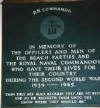  Subject.
RN (Beach) Commandos. Subject.
RN (Beach) Commandos.
Location.
The
memorial plaques on the left are situated in Ardentinny Church on Loch Long
in Scotland, close to where the RN Commandos training base at HMS Armadillo was located.
Other Information.
The primary task of the RN Commandos was to control the movement of men,
vehicles and supplies through the landing beaches, during major amphibious
landings. The avoidance of bottlenecks and delays gave them a pivotal role
in the supply chain. More information at Royal
Navy Beach Commandos.
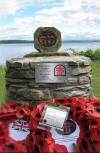   Subject.
RN (Beach) Commandos. Subject.
RN (Beach) Commandos.
Location. The memorial cairn is near the village of Ardentinny on the shore of Loch Long in Scotland, where
the RN Commandos training base at HMS Armadillo was located.
Other Information. On the 15th of February, 2001, Ken Oakley, Chairman of the RN Commando
Association, wrote to Tommy Hamilton
"Ted
Hinchcliffe made the memorial stone (crossed the bar Jan 01). He was very
proud of making it out of Yorkshire stone". In
the same letter,
Ken asked
Tommy if he would paint in the letters, which he did. His son, David,
subsequently refreshed the lettering.
 The memorial stone was originally placed
outside
the front door of the old Forestry Commission (FC) office. When the building
was demolished, Ian Adams of the FC, moved the stone to a safe location
about 30 metres away.
The
cairn, seen in the photos above, was built by FC workers, Stephen Cooper and
Ben Blowers in time for Remembrance Sunday, 2013. The memorial stone was originally placed
outside
the front door of the old Forestry Commission (FC) office. When the building
was demolished, Ian Adams of the FC, moved the stone to a safe location
about 30 metres away.
The
cairn, seen in the photos above, was built by FC workers, Stephen Cooper and
Ben Blowers in time for Remembrance Sunday, 2013.
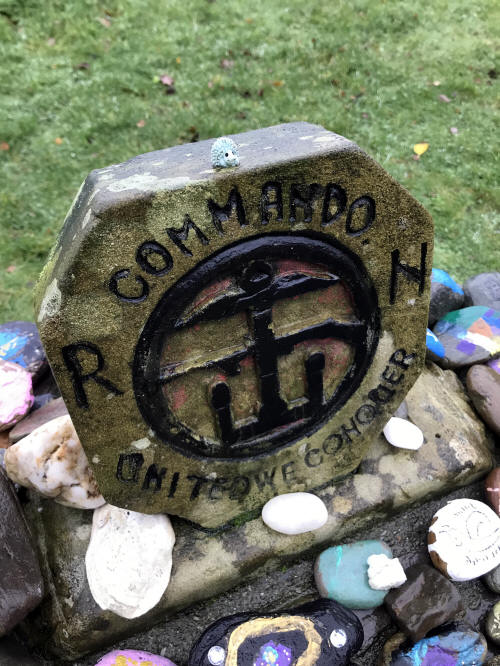 The
people of Ardentinny have always kept the area around the memorial stone
tidy. Flowers, and bulbs in pots, are often placed near the stone as an act
of remembrance. [Photos courtesy of Tony
Rodaway]. The
people of Ardentinny have always kept the area around the memorial stone
tidy. Flowers, and bulbs in pots, are often placed near the stone as an act
of remembrance. [Photos courtesy of Tony
Rodaway].
Bob Hinchcliffe, son of
Ted (mentioned above) wrote in Nov 2021; "My wife discovered that my father had
carved the Ardentinny memorial stone from Yorkshire grit many years ago and
presented it to the then Combined Operations Association. We visited Ardentinny
on Remembrance Sunday to pay our respects to my father and his RN Commando
comrades who trained there in the early 1940s. The memorial stone sits proudly
and securely on top of a cairn overlooking Ardentinny Beach. Local children have
added painted beach pebbles to the cairn.
A local couple, who visit
the memorial each year, also attended at 11.00. They run a local history group
and were very knowledgeable about RN Commando activities and the history of the
local training base.
We then took a walk along
the beach and, on our return, we found a small toy hedgehog sitting on top of
the memorial stone. It was such a sweet, heart-warming gesture on a special day
of remembrance.
Kind regards
Bob
  Subject.
Commando/Lochaber Commemorative Stone. Subject.
Commando/Lochaber Commemorative Stone.
Location. Near Fort William town centre on the Parade close to
the War Memorial.
Other Information.
The unveiling of a commemorative stone took
place on Saturday 13 November, 2010. It
celebrates the friendship that the people of Lochaber and the Commandos
have shared since early 1940. Erected by the Commando Veterans
Association. [Photos courtesy of Martin Briscoe].
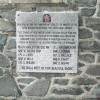  Subject.
The Cockleshell Heroes (Operation Frankton). Subject.
The Cockleshell Heroes (Operation Frankton).
Location.
On the shore of the Holy Loch in the village of Ardnadam. Shortest route from
the south is via the ferry from Gourock to Dunoon.
Other Information.
The Royal Marine Boom Patrol was the misleading name given to a small group
of highly trained Royal Marines, who used small collapsible canvas craft for
clandestine operations against the enemy.
More information about the Cockleshell
Heroes here. [Photos courtesy of Tony Rodaway].
  Subject. The
Loss of Two Hurricane Pilots, while taking part in a
combined training exercise. Subject. The
Loss of Two Hurricane Pilots, while taking part in a
combined training exercise.
Location. Ardnamurchan Peninsula,
Scotland (see map). A long walk over rough terrain is involved.
Other
Information. Erected and
consecrated in 1995 at the instigation of Phillip Jones. More
information at
516 Combined Operations Squadron.
FRANCE
 Subject.
The British Normandy Memorial
bears the names of 22,442 individuals: British personnel and those of other
nationalities who were serving in British units, who died while taking part
in D-Day and the Battle of Normandy. This includes people from more than 30
different countries. Individuals who were serving in units (such as ships,
army battalions or air force squadrons) that belonged to other national
forces are not included, though they often fought closely alongside British
forces. Subject.
The British Normandy Memorial
bears the names of 22,442 individuals: British personnel and those of other
nationalities who were serving in British units, who died while taking part
in D-Day and the Battle of Normandy. This includes people from more than 30
different countries. Individuals who were serving in units (such as ships,
army battalions or air force squadrons) that belonged to other national
forces are not included, though they often fought closely alongside British
forces.
Location. The British Normandy
Memorial is located just off the D514 in the commune of Ver-sur-Mer,
Calvados. It is about 25 minutes from the outskirts of Caen or Bayeux. If
you are using a Sat Nav please use the address: 13 Avenue Paul Poret,
Ver-sur-Mer, 14114. Vehicular access to the Memorial is from either
Courseulles (to the East) or Arromanches (to the West) and along the D514
coast road in order to avoid approaching Ver-sur-Mer from the South.
[Information and photo from the
British Normandy Memorial
website].
 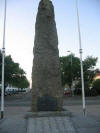 Subject. Operation Chariot
- the raid on the dry dock at St Nazaire. Subject. Operation Chariot
- the raid on the dry dock at St Nazaire.

Location. St Nazaire, France. The memorial and the 12 pounder gun,
taken from HMS Campbeltown, are situated side by side at Place du
Commando, which is at the eastern end of Boulevard President Wilson.
Other Information.
The inscription below the gun reads 'Canon du destroyer Cambeltown
qui percuta le caisson sud de la forme joubert Commando Anglais du 28 Mars,
1942'.
Click here for more information
on Operation Chariot. Photos courtesy of Graham Francis.
  Subject. The Operation Frankton
Memorial to the Cockleshell Heroes. More information
here. Subject. The Operation Frankton
Memorial to the Cockleshell Heroes. More information
here.
Location.
Le Verdon, France.
Other Information.
Taken
after the dedication ceremony on 31/03/11, courtesy of
Eric Lincontang.
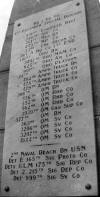 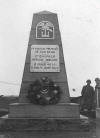 Subject.
US 1st Engineer Special Brigade.
The inscription reads; In proud memory of our dead. 1st Engineer Special
Brigade. H Hour was 6.30 hr on D Day, 6th June, 1944. Subject.
US 1st Engineer Special Brigade.
The inscription reads; In proud memory of our dead. 1st Engineer Special
Brigade. H Hour was 6.30 hr on D Day, 6th June, 1944.
Location. It is known
that some memorials were constructed during, or shortly after, WW2 as per
this explanation by Charles B
MacDonald, a former deputy chief historian at the US Army's Center of
Military History.
Soon after the end of the war, veterans
of the 1st Engineer Special Brigade, which incurred the heaviest losses in
Exercise Tiger, did just that, erecting a
monument on
Omaha Beach (now known to be Utah Beach - see below)
to their dead, presumably to include those
who died at Utah Beach and those who died in preparation for D-Day.
One source
indicates that the memorial was unveiled in June 1945.
  Other Information.
One
visitor writes...
My father
was part of that unit. He camped near that spot on the beach. There's an
interesting book called Storming Ashore, by Kenneth Garn (available on
Amazon) about the 1st Engineers Special Brigade. The book notes that the
monument was on the site of one of the first German machine gun pillboxes seized
on Utah Beach on D-Day. Other Information.
One
visitor writes...
My father
was part of that unit. He camped near that spot on the beach. There's an
interesting book called Storming Ashore, by Kenneth Garn (available on
Amazon) about the 1st Engineers Special Brigade. The book notes that the
monument was on the site of one of the first German machine gun pillboxes seized
on Utah Beach on D-Day.
A number of years ago I visited Utah beach. And there it was. It was part
of our family history to show children photographs taken when we were at
Utah.
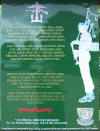  Subject.
The action to take Pegasus Bridge. Subject.
The action to take Pegasus Bridge.
Location.
The Cafe Grandee near Pegasus Bridge.
Other
Information. See text on the plaque. [Photos courtesy of Bern
and Fay Robins].
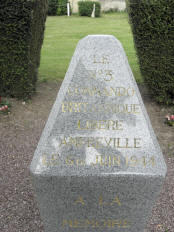 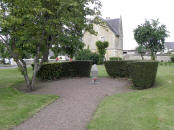 Subject.
No 3 Commando Memorial. Subject.
No 3 Commando Memorial.
Location.
Le Plain / Amfréville.
Other Information.
3 Commando liberated the town on June 6th, 1944. The memorial remembers those
who died in the action. [Google Earth 'Amfreville, France'. 49 14 55 81 N 0
14 08 64 W].
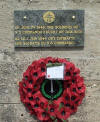  Subject. No 3 Commando action at Merville Battery. Subject. No 3 Commando action at Merville Battery.
Location.
In Normandy near the village of Merville-Franceville
on the D514.
Other Information.
During the early hours of D-Day, 6th June,
1944, the German Battery of 4 guns was seized by the 9th Parachute Battalion
and the guns put out of action. On June 7, Nos 4 and 5 troops of No 3
Commando, under Major JBV Pooley, MC, on orders from the 6th Airborne
Division, attached the strongpoint which had been reoccupied by the Germans.
It was recaptured in a gallant action, in which many casualties were
suffered. The photos were taken at the laying ceremony on the 61st
Anniversary of the action. [Photos by Bern and Fay Robins].
  Subject.
No 3 Commando 1st Special Services Brigade. Subject.
No 3 Commando 1st Special Services Brigade.
Location. Petiville,
France.
Other Information. Under the command of Lt Col Peter Young the
brigade liberated Petiville on August 17th, 1944. [Photos courtesy of Bern
and Fay Robins].
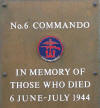 _small.jpg) Subject. No 6
Commando. Subject. No 6
Commando.
Location.
Amfreville -
in the town centre near the church.
Other Information.
Photos provided by Bern & Fay Robins.
  Subject. 45 Commando, who were killed on the 6th - 8th
June, 1944, at Merville Franceville. Subject. 45 Commando, who were killed on the 6th - 8th
June, 1944, at Merville Franceville.
Location. Next to the Mairie at the roundabout up to Merville Battery,
junction of Route de Cabourg (D514) and Avenue Alexander de Lavergne.
Other Information. Michael Partington
writes; My dad is Graham Partington, temp Lt, ex B Troop 45, RM Commando, 1944-47. He was with No1 Special Service Brigade on D Day and
was with 45, when they crossed the Rhine at Wesel in 45. I recently visited
the memorial and placed a wreath on behalf of my dad. The memorial is
beautifully kept but it does not seem well visited. A wreath, laid over 12
months earlier, was still in position. It may just be that it is not well
known.
   Subject.
The RM
Commando. Subject.
The RM
Commando.
Location. at Sannerville a few miles east of Caen.
Other
Information. The mason was Auvray Djonny and the Architect Marcel Conti.
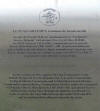 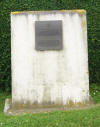 Subject. Commando Action in the area of Le Plain
Gruchet. Subject. Commando Action in the area of Le Plain
Gruchet.
Location.
Goustranville, near the Auge Hills, between the N175 and D27
Roads.
Other Information.
The action involved the British 1st Special
Services Brigade (No 3, 4, 6 Commando, 45 RM Commando and the 1st Battalion
of the French Marine Brigade). [Photos courtesy of Bern and Fay Robins].
  Subject.
The
Royal Canadian Army Service Corp
(RCASC), who served on D-Day
and in the Battle of Normandy. Subject.
The
Royal Canadian Army Service Corp
(RCASC), who served on D-Day
and in the Battle of Normandy.
Location.
The “BOLD” tank in the town square of Courseulles-sur-Mer, Normandy, France. (Juno Beach).
Other Information. This Sherman tank,
of the 1st Hussars nicknamed 'Bold,' sunk on D-Day and was pulled from the
water in 1971 (with the assistance of 4 Service Bt). It was restored and
over the years bronze plaques have been added, commemorating the Canadian
units, regiments and corps, which took part in the landing. The plaque
was unveiled on
7 June, 2004.
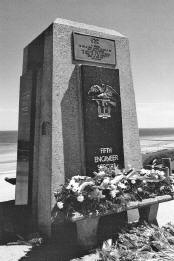 Subject.
US 5th
Engineer Special Brigade. Subject.
US 5th
Engineer Special Brigade.
Location. Omaha Beach, France.
Other
Information. Tom Bryan
writes from the USA; The photo is of the recently refurbished
monument. A few years ago the (British) Combined Ops/(American) Amphibious
insignia was stolen, so this year a few members of our group, the 348th
Family & Friends, had a new emblem made. They met in France a few days prior
to the D Day ceremonies and installed the insignia and made some repairs to
the monument. An unveiling ceremony was held on June 5, which was attended
by about 300.
 Subject. Crews of Landing Craft and Landing
Ships. who died in action off Normandy. Subject. Crews of Landing Craft and Landing
Ships. who died in action off Normandy.
Location.
Arromanches,
Normandy, France.
Other Information.
Photo courtesy of
Andrew Bystram
NETHERLANDS
  Subject. The landing of the
52nd Lowland Division on 1st Nov,
1944 against entrenched German defensive positions. Subject. The landing of the
52nd Lowland Division on 1st Nov,
1944 against entrenched German defensive positions.
Location. 'Uncle Beach' Vlissingen, Walcheren
Island, Scheldt Estuary, Holland.
Other Information. The heavily fortified island blocked the River Scheldt
to Allied shipping and thereby to the newly captured Antwerp. Full story
on this link;
Walcheren.
  Subject. The landing of No
4 Commando Brigade*on 1st Nov, 1944 against entrenched German defensive positions. Subject. The landing of No
4 Commando Brigade*on 1st Nov, 1944 against entrenched German defensive positions.
Location. Westkapelle, Walcheren
Island, Scheldt Estuary, Holland.
Other Information. The heavily fortified island blocked the River Scheldt
to Allied shipping and thereby to the newly captured Antwerp. Full story
on this link; Walcheren. [*
At the time of the action they were called No 4 Special Services
Brigade, being re-designated No 4 Commando a few weeks later].
  Subject. No 4 Commando. Subject. No 4 Commando.
Location. Flushing, Walcheren Island,
Scheldt Estuary, Holland, near
the Orange Mill (where they landed).
Other Information. The original
plaque attached to the monument is not in place in this photo (left) but
the text can be seen in the photo (right). Full story on this link; Walcheren.
REST OF THE WORLD
  Subject. The Royal Australian Navy Beach
Commando. Subject. The Royal Australian Navy Beach
Commando.
Location. AUSTRALIA: Cairns, Queensland.
Other Information.
The Commando units were formed (literally) on the beaches just North of
Cairns. They subsequently played out their part in
the numerous amphibious operations throughout the latter stages of the
Pacific Campaign. They were modelled on their RN counterparts and were very
proud of their adopted motto: “First in, last out”. A small memorial
and plaque are the only local reminder of the high drama played out here
during those dark days. [Photos and text from Scott Derrington].
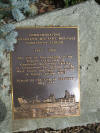  Subject.
Canada; The site of WW2 Combined Operations Training. Subject.
Canada; The site of WW2 Combined Operations Training.
Location. CANADA: Courtenay, Vancouver Island, British Columbia. At Simms Millennium Park, in Courtenay, a
large display board provides details of the park, including a bit of history
of the area associated with Combined Operations.
Other information. Initially, the training
and provision of landing craft was a defensive measure, at a time when invasion of the
Canadian west coast, by Japanese forces, was a distinct possibility. Later the
emphasis turned to the European theatre of war.
 The
Canadian Navy base, known as Givenchy III, commissioned in late 1943, was located
on The Spit (centre, in a bay in adjacent photo) and connected to the town
of Comox (right foreground), on Vancouver Island. The town of Courtenay, a
few km. away from Comox, can be seen in right background.
[Photos courtesy of Gord Harrison]. The
Canadian Navy base, known as Givenchy III, commissioned in late 1943, was located
on The Spit (centre, in a bay in adjacent photo) and connected to the town
of Comox (right foreground), on Vancouver Island. The town of Courtenay, a
few km. away from Comox, can be seen in right background.
[Photos courtesy of Gord Harrison].
 Subject.
The construction of top secret experimental "ice ships"
in 1943. Subject.
The construction of top secret experimental "ice ships"
in 1943.
Location. CANADA: Patricia Lake,
Jasper, Alberta. A few miles outside the town.
Other information. Plaque was erected by the National Research Council of Canada in 1989.
More information on this site at
Pykrete - Ice Ships.
  Subject.
Operation Hardtack 28. Subject.
Operation Hardtack 28.
Location. CHANNEL ISLANDS:
Jersey, Channel Islands.
Other information. On 25/26 December, 1943, a team of eight from
No 8 French Troop of No 10 Inter-Allied Commando and No 12 Commando landed
on Jersey to take a sample of barbed wire and to capture prisoners. They
landed at Petit Port, climbed the cliff but failed to locate a German
soldier. On their return to the beach, a mine was set off, seriously injuring
Captain Ayton who sadly died of his wounds back in England.
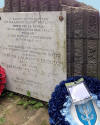  Subject. SAS Operation Speedwell, September 7, 1943. Subject. SAS Operation Speedwell, September 7, 1943.
Location. ITALY: Cisa Pass. N44.46948 /
E009.93143
Other information. Operation Speedwell was
designed to disrupt transportation of military supplies from the Po valley
to the German front lines at Salerno, Calabria and Taranto. Six SAS
operatives parachuted into Italy on what was a high-risk operation that met
with only limited success. Dudgeon and Brunt were captured and executed at
the Cisa Pass. [Photos by Tim Ford].
  Subject. SAS Operation Speedwell, September 7, 1943. Subject. SAS Operation Speedwell, September 7, 1943.
Location. ITALY: Ponsano Magra (located a few
miles North West of Sarzana), Italy. N44.14246 / E009.94427
Other information. Operation Speedwell was
designed to disrupt transportation of military supplies from the Po valley
to the German front lines at Salerno, Calabria and Taranto. Six SAS
operatives parachuted into Italy on what was a high-risk operation that met
with only limited success. Foster and Shortall were captured and executed at
Ponsano Magra.
|
















































_small.jpg)





























